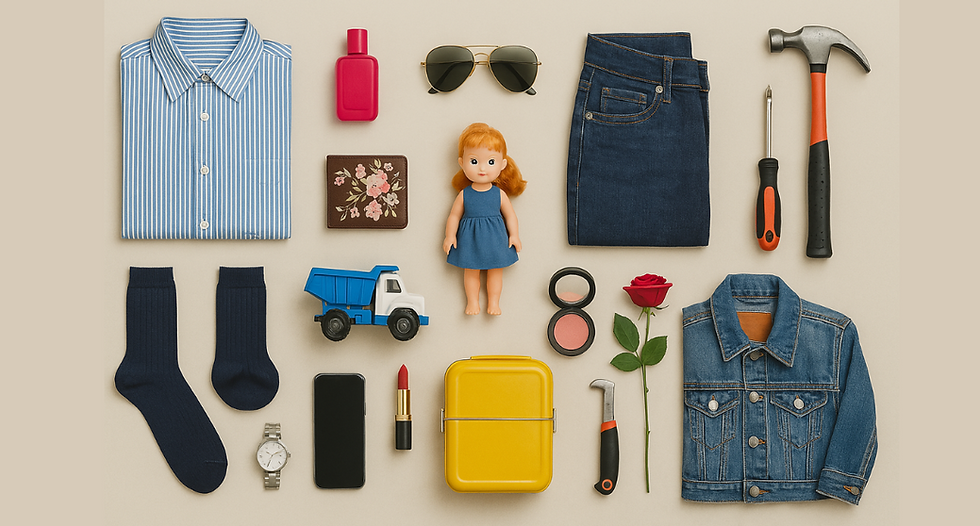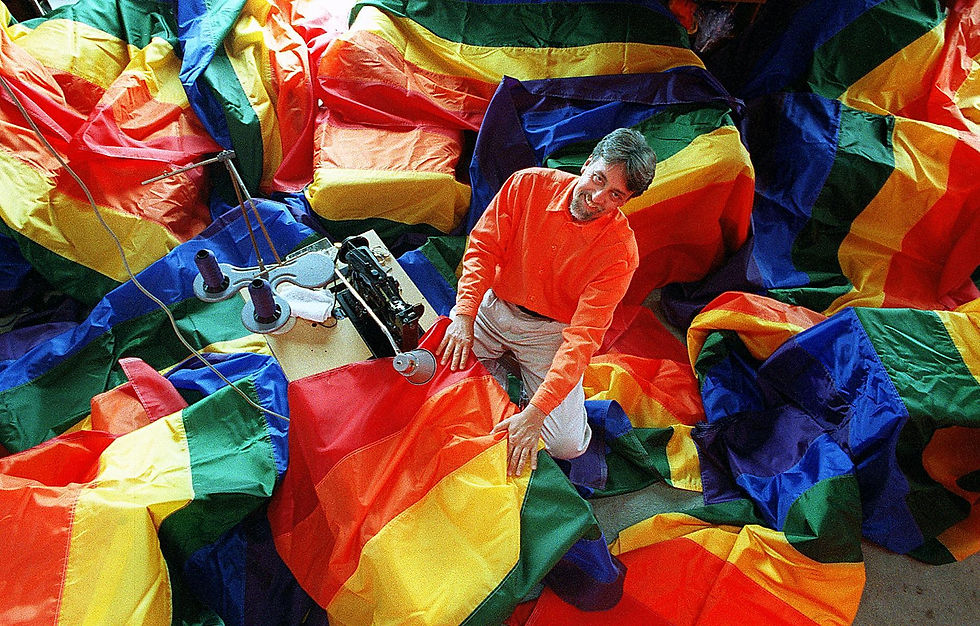What Objects Teach Us About Gender—And Ourselves
- Sonal Giani
- Apr 15
- 5 min read
What Objects Teach Us About Gender—And Ourselves

Have you ever picked up something you liked—a shirt, a perfume, a pair of sunglasses—and then hesitated?
Not because it didn’t suit you, or didn’t fit, but because somewhere in the back of your mind, a quiet voice said, this isn’t for you.
Maybe you were a little boy who liked shiny things, but someone steered you toward something “more boyish.” Maybe you were told not to play too rough because “girls don’t do that.” Maybe you chose the navy socks over the yellow ones. The plain wallet instead of the one with flowers. The muted backpack. The neutral phone case. Nothing dramatic. Just small, silent edits—made not out of preference, but out of caution.
Most of us have done this. We may not even remember when we started. We don’t always know we’re doing it. It’s just… what we’ve learned.
We grow up in a world full of invisible cues. Pink means soft. Blue means strong. Glitter is frivolous. Grey is dependable. A dress is feminine. A toolset is masculine. These are not objective truths, but they are treated as if they are. A baby shower is held, and the colours are chosen before the baby has spoken a single word. A child picks up a toy, and someone nearby redirects their hand. Over time, we absorb the messages: this is for boys, that is for girls. This means toughness. That means care. This is who you should be.
The term "gender" often gets confused with "sex," but they are not the same thing. Sex is assigned at birth based on biological characteristics. Gender, on the other hand, is a social construct—it’s the set of roles, behaviours, expectations, and even aesthetics that societies associate with being male, female, or somewhere in between or beyond. Gender is learned. It is performed. It is enforced.
And yes, it can be changed.
One of the ways we learn gender is through objects. And one of the strongest enforcers of gendered objects is advertising.
Take razors, for example. In the early 1900s, razor companies in the U.S. had a problem: they’d saturated the male market. So they began to market shaving to women—not as an optional grooming habit, but as a necessity tied to femininity, hygiene, and desirability. Hair removal became “feminine,” not because women asked for it, but because advertisers created the need.
The same thing happened with colors. For centuries, children—regardless of sex—wore white. It was only in the early 20th century that pink and blue were assigned gendered meaning, and even then, it wasn’t consistent. Pink, being a derivative of red, was seen as bold and powerful—ideal for boys. Blue, thought to be daintier and serene, was more suited to girls. It wasn’t until mid-century marketing campaigns pushed blue for boys and pink for girls that the current “rule” took hold.
Even cigarettes were once gendered. When women began smoking in public, it was considered scandalous—until Edward Bernays, the father of modern public relations, launched the 1929 “Torches of Freedom” campaign, aligning cigarettes with women’s liberation. The shift wasn’t moral or scientific. It was strategic. An object once seen as masculine suddenly became a symbol of feminine independence. Because someone decided to sell it that way.
Lipstick, bicycles, jeans, motorbikes, denim jackets, backpacks, even colors and fonts—all have been assigned to one gender or another, and then reassigned, depending on what was being sold, and to whom.
So when people say, “That’s just how things are,” it’s worth asking: Who made it that way? And what were they trying to sell?
Across time and geography, gendered associations with objects have never been as fixed as they feel. They shift, often quietly, and often in response to power, politics, and profit. In some parts of the world, men wear robes and sarongs, carry babies in slings, wear makeup or adorn their hair with flowers—without it being seen as subversive. In other parts of the world, women are mechanics, soldiers, boxers, and carpenters—without being seen as unwomanly. A sari might mean elegance in one place, and resistance in another. A suit might mean power in one decade, and conformity in another.
When we zoom out, we see that these meanings—of what an object “says” about someone—are not natural. They are contextual. And they are changeable.
So when someone breaks a gender norm by using an object differently, they’re not creating chaos. Often, they’re creating possibility.
Think about the first women to wear trousers in public. The ridicule they faced. The outrage. And now—can you imagine a world where women were still expected only to wear skirts? Or the first men to carry their babies in public, using soft carriers or pushing prams. Or queer people using makeup and fashion not to “confuse” anyone, but to feel whole. These shifts didn’t fracture society. They opened it.
Sometimes, breaking a gender rule with an object can change everything.
It’s not just about what you wear. It’s about who you get to be while wearing it. When people are free to make those small choices without shame—pink socks, power tools, flowers on a wallet, glitter on shoes—it leads to bigger choices. Choices about how to love. How to express care. How to raise children. How to lead. How to live.
And this isn’t just about queerness. It’s about all of us. Because the same rules that limit queer and trans people also limit everyone else. They make men afraid to cry. They make women afraid to take up space. They make children afraid to experiment. They make softness suspect and joy conditional.
You don’t have to identify outside the binary to feel these limits. You just have to have been a child once. A teenager picking out clothes. A parent choosing a toy. A person making a choice and wondering if that choice would be too noticeable.
When we begin to notice where those worries come from, we start to see the system behind them. And we get the chance to loosen its grip—not just for others, but for ourselves.
No, changing the meaning of objects won’t destroy society. It already hasn’t. It’s been happening for centuries, quietly and constantly. What it does is expand the space in which we can be fully human.
So the next time you see someone wearing something that surprises you—or using an object “differently”—pause before judging. Ask yourself where that discomfort really comes from. And ask yourself how often you’ve made a choice just to avoid that same gaze.
A pair of earrings doesn’t have gender. A fragrance doesn’t. A toy, a lunchbox, a flower, a jacket—they don’t know anything about gender. They only carry the meaning we give them.
And if that’s true, we can begin again. We can make new meanings. Kinder ones. Braver ones. Truer ones.
And maybe in doing that, we give ourselves just a little more freedom too.



Comments